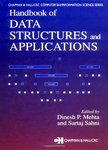版权所有:内蒙古大学图书馆 技术提供:维普资讯• 智图
内蒙古自治区呼和浩特市赛罕区大学西街235号 邮编: 010021

丛 书 名:Chapman & Hall/CRC computer and information science series
版本说明:1
I S B N:(纸本) 9781584884354
出 版 社:Chapman and Hall/CRC
出 版 年:2004年
主 题 词:Literary Collections
摘 要:In the late sixties, Donald Knuth, winner of the 1974Turing Award, published his landmarkbook The Art of Computer Programming: Fundamental Algorithms. This book brought to-gether a body of knowledge that defined the data structures area. The term data structure,itself, was defined in this book to be A table of data including structural *** Wirth, the inventor of the Pascal language and winner of the 1984 Turing award,stated that “Algorithms + Data Structures = Programs. The importance of algorithmsand data structures has been recognized by the community and consequently, every under-graduate Computer Science curriculum has classes on data structures and algorithms. Bothof these related areas have seen tremendous advances in the decades since the appearanceof the books by Knuth and Wirth. Although there are several advanced and specializedtexts and handbooks on algorithms (and related data structures), there is, to the best ofour knowledge, no text or handbook that focuses exclusively on the wide variety of datastructures that have been reported in the literature. The goalof this handbook is to providea comprehensive survey of data structures of di?erent types that are in existence *** this end, we have subdivided this handbook into seven parts, each of which addressesa di?erent facet of data structures. Part I is a review of introductory material. Althoughthis material is covered in all standard data structures texts, it was included to make thehandbook self-containedand in recognitionofthe factthatthere aremany practitionersandprogrammers who may not have had a formal education in Computer Science. Parts II, III,and IV discuss Priority Queues, Dictionary Structures, and Multidimensional structures,respectively. These are all well-known classes of data structures. Part V is a catch-all usedfor well-known data structures that eluded easy classification. Parts I through V are largelytheoretical in nature: they discuss the data structures, their